|





















Expeditions





| |
Kate
Brogdon
I
started painting and sculpting prior to starting speech and have been marking
and making things since. I discovered photography later when my dad first
allowed me to click the shutter of the 110 camera. Single grainy frames were
lots of fun, but I really coveted Dad's screw-mount SLR. I used that camera and
a variety of other SLRs, eventually graduating to the "analog" Nikon I still
use. The photography habit continued on and off through college, commissioning,
schools, many work hours, evolving into the deployment "cargo pocket" camera.
After drowning the first one kayaking, my husband replaced it and added a
waterproof case, watertight to 130 feet. The next logical leap was to try it
while diving…
Nate and I landed
separately in Okinawa a decade ago in a complete accident of assignment,
snorkeled a lot, but didn't dive until we returned in 2002. It took a year
before we started diving and another before we incorporated the photography
element. Since then, we've been in the water every opportunity and usually at
least one of us is photographing. The trick is to get something worth
photographing to swim in front of the lens and click the shutter at the right
time.
Pictures are from
Ishigaki, Yaeyema, the southernmost group of Ryukyu Islands , Nov 2005
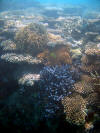 We snorkeled during our surface interval the first day of diving in
Ishigaki. This amazing, dense, healthy coral (sango) grew right off the
boat dock of Aragasuki Island , also called “Panari” (separated.) The
blue coral is the most distinctive of Ishigaki’s corals. It is blue
throughout, although I did not attempt to break any to check that fact
We snorkeled during our surface interval the first day of diving in
Ishigaki. This amazing, dense, healthy coral (sango) grew right off the
boat dock of Aragasuki Island , also called “Panari” (separated.) The
blue coral is the most distinctive of Ishigaki’s corals. It is blue
throughout, although I did not attempt to break any to check that fact |
 More amazing coral
with the small blue chromis that like to shelter in its branches
More amazing coral
with the small blue chromis that like to shelter in its branches |
 This was a site called
Hanahige (mustache – no idea why) the first day of diving. The site was
islands of coral scattered throughout the white sand sea floor. We saw a
wide variety of corals and fish, a few eels (unagi) and nudibranchs (umi
ushi). We also saw a large, incredibly beautiful tiger cowry. Large
schools of fish congregated in areas. The sand gave the additional
benefit of bouncing additional light for photos.
This was a site called
Hanahige (mustache – no idea why) the first day of diving. The site was
islands of coral scattered throughout the white sand sea floor. We saw a
wide variety of corals and fish, a few eels (unagi) and nudibranchs (umi
ushi). We also saw a large, incredibly beautiful tiger cowry. Large
schools of fish congregated in areas. The sand gave the additional
benefit of bouncing additional light for photos. |
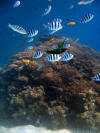 This was also at
Hanahige. The green bird wrasse darted amongst the striped sergeants and
popped inquisitively toward me every so often. I think they were
expecting a handout.
This was also at
Hanahige. The green bird wrasse darted amongst the striped sergeants and
popped inquisitively toward me every so often. I think they were
expecting a handout. |
 The second day we dove
with mantas (iitomaki ei) as we would every other day. They would cruise
up to us curiously singly or in groups up to three, then sheer off at
the last minute. This site was the “Manta scramble” or “Manta
sukuranburu” and even the one day the mantas didn’t show it was
beautiful. The corals were incredible and various schools of fish
populated the area. We saw schools of smaller tuna (isomaguro) near the
surface.
The second day we dove
with mantas (iitomaki ei) as we would every other day. They would cruise
up to us curiously singly or in groups up to three, then sheer off at
the last minute. This site was the “Manta scramble” or “Manta
sukuranburu” and even the one day the mantas didn’t show it was
beautiful. The corals were incredible and various schools of fish
populated the area. We saw schools of smaller tuna (isomaguro) near the
surface. |

Here was one of the
mantas turning on his run toward me. |
 The same manta (note
the remoras) curious about this strange bubble-blowing creature in its
world.
The same manta (note
the remoras) curious about this strange bubble-blowing creature in its
world. |
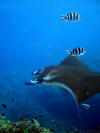 Another manta run
with numerous schools of fish. The variety of fish was incredible
Another manta run
with numerous schools of fish. The variety of fish was incredible |
 Again, you can see the
big guy turning, recognizable with his remora ornamentation.
Again, you can see the
big guy turning, recognizable with his remora ornamentation. |
 This taken at Taketomi
haitei onsen, of Taketomi hot spring. The intent of the dive was to
bring us to a hot spring in the ocean floor. After we played with the
hot, shimmering water for a few minutes, I found this shrimp (ebi) on
its coral home.
This taken at Taketomi
haitei onsen, of Taketomi hot spring. The intent of the dive was to
bring us to a hot spring in the ocean floor. After we played with the
hot, shimmering water for a few minutes, I found this shrimp (ebi) on
its coral home. |
 The next day we dove
near Irimote Island at a site called Barasu (to expose a secret) and saw
turtles (kame), rays (ie), huge moray eels and flatworms (hiramushi).
This photo was taken during the surface interval snorkel. The color and
variety of coral was wonderful.
The next day we dove
near Irimote Island at a site called Barasu (to expose a secret) and saw
turtles (kame), rays (ie), huge moray eels and flatworms (hiramushi).
This photo was taken during the surface interval snorkel. The color and
variety of coral was wonderful. |
 Same site near Irimote.
The chromis would dart into the sheltering coral if I became too close
and then slowly drift out when they started to feel safer.
Same site near Irimote.
The chromis would dart into the sheltering coral if I became too close
and then slowly drift out when they started to feel safer. |
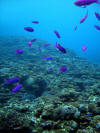 Back at Manta scramble,
I photographed these iridescent purple queens (hanagoi). They seem to
enjoy the current, their schools forming arcs. It was rather wavy that
day.
Back at Manta scramble,
I photographed these iridescent purple queens (hanagoi). They seem to
enjoy the current, their schools forming arcs. It was rather wavy that
day. |
 This was also the Manta
scramble. Several groups of mantas began circling the area and a number
of divers had congregated around a coral head watching them. Mostly the
mantas stayed on the other side of the bommie, so we only saw the
occasional wing flaring out through the bubbles, but this group came
right over us and gave us a good view. Imagine if you will a ring of
bubbles from the 40-50 divers all entranced by the rays flying around.
This was also the Manta
scramble. Several groups of mantas began circling the area and a number
of divers had congregated around a coral head watching them. Mostly the
mantas stayed on the other side of the bommie, so we only saw the
occasional wing flaring out through the bubbles, but this group came
right over us and gave us a good view. Imagine if you will a ring of
bubbles from the 40-50 divers all entranced by the rays flying around. |
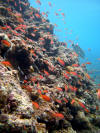 Osaka
hanagoi
riifu (Anthias reef) was a steeply
sloping site with a series of bowl shapes deepening from coral to rock.
The site is named for the anthias (hanagoi )
marked with square patches on their sides found in the area. Other
anthias were numerous as well, including the orange anthias in this
picture, along with a patterned grouper (hata). We
also saw huge fans (isobana) bigger than
me, featherstars (hana umishida), scorpion fish (onikasago) and a number
of umi ushi.
Osaka
hanagoi
riifu (Anthias reef) was a steeply
sloping site with a series of bowl shapes deepening from coral to rock.
The site is named for the anthias (hanagoi )
marked with square patches on their sides found in the area. Other
anthias were numerous as well, including the orange anthias in this
picture, along with a patterned grouper (hata). We
also saw huge fans (isobana) bigger than
me, featherstars (hana umishida), scorpion fish (onikasago) and a number
of umi ushi. |
 This site was “Ritoru
sando paradise” or Little sand paradise. Small islands of rock and coral
were scattered about white sand sea floor. This particular rock had red,
white and blue schools swirling around it, with several anemones (kumanonu)
supplying their own fish. We also saw the well camouflaged leaf fish (hadakata
okoze) which I hadn’t seen before.
This site was “Ritoru
sando paradise” or Little sand paradise. Small islands of rock and coral
were scattered about white sand sea floor. This particular rock had red,
white and blue schools swirling around it, with several anemones (kumanonu)
supplying their own fish. We also saw the well camouflaged leaf fish (hadakata
okoze) which I hadn’t seen before. |
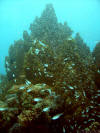 Our last day of diving
was at “Midoru hon” or Middle book. This was another site with islands
of coral on the white sand. This particular island was a castle about
20’ tall with huge schools of small fish. We saw more groupers, shrimps,
stone fish (onedaruma shoze) and the juvenile emperor angelfish with
alternating colors of blue bulls-eyes on his blue field. We also saw the
biggest helmet shell I’ve seen outside a shell shop – alive!
Our last day of diving
was at “Midoru hon” or Middle book. This was another site with islands
of coral on the white sand. This particular island was a castle about
20’ tall with huge schools of small fish. We saw more groupers, shrimps,
stone fish (onedaruma shoze) and the juvenile emperor angelfish with
alternating colors of blue bulls-eyes on his blue field. We also saw the
biggest helmet shell I’ve seen outside a shell shop – alive! |
Some more translations
of what we saw:
Minokasago - lionfish
Sentakasago - fuseliers
Tsubametamabataone -
upside down
Koshodai - many spotted
sweetlips
Hiranaga nejirinbo -
gobi
Heroiyurihaze -
two-tone dartfish
Futairo hanagoi
– type of
anthias
Onedaruma shoze -
stonefish
Akashima shira hige ebi
-cleaning shrimp
|
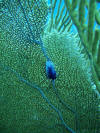
Fan clam
First dive in
Belize, at Shark Canyon, Ambergris Caye. Gorgeous, waving soft coral forest as
seen in all our dives here. This is part of the Belize barrier reef, the
longest in the northern hemisphere and second longest in the world.
 Feeding Feeding
Eagle Ray Aquarium, Half Moon Caye, following our dive in the
Blue Hole. Ball o’ fish was created by one of the divemasters spreading food
in the water. This Caye is one of Belize’s atolls.
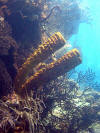 Sponges Sponges
Tall sponges grew
everywhere, but especially at Half Moon Caye. Often, small creatures hid
inside.
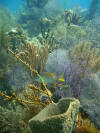 Snapper coral
Snapper coral
Coral forest
wonderland at Half Moon Caye.
 Stoplight
parrot fish Stoplight
parrot fish
Stoplight
parrot fish at Half Moon Caye
 Turtle
Nate Turtle
Nate
Boca
del Rio on Ambergris Caye. This elder statesman swam
up to our group of divers and thoroughly inspected us one by one. Then he
torpedoed into the blue.
 Turtle
wrasses Turtle
wrasses
Boca
del Rio. This younger guy munched contentedly, not
paying much attention to us. We hung out, took pictures and then left him still
snacking. Blue head wrasse trail the turtle. We saw
these distinctive fish every dive. Some of the turtles ignored us, some zoomed
away as fast as they could – and they can zoom when they want to! It was
apparent some turtles had previous negative experiences with divers, like being
grabbed.
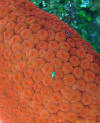 Coral
shell shrimp Coral
shell shrimp
Boca
del Rio.
 Needle
fish Needle
fish
Our last day of
diving in Belize started at Hol Chan Canyon, a protected preserve. The game
wardens check for dive boats stopped in the park, charging the dive operators
according to their filed diver logs. Our divemaster was complaining about the
cost, but it was less than $10 – I think we can afford that! We saw lots of
fish everywhere, but here especially. Schools of needle fish congregated in the
shallow snorkel spot for during our surface interval.
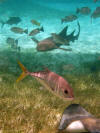 Shark
jack ray Shark
jack ray
Hol Chan Canyon. This was in a very shallow area (less than 10
feet) and numerous fish were cruising about like it was their highway.
 Squid Squid
Last dive in
Belize, at Amigo Wreck, Ambergris Caye. A “carpet” of squid shimmered into view
during our safety stop. I had to drop down for a photo and start my time over.

|




























